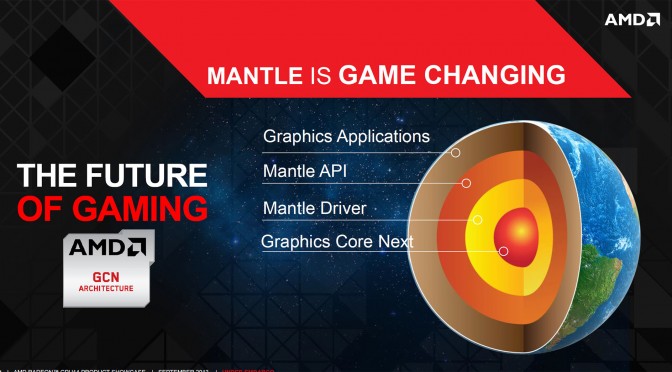AMD has released a 20-minute video in which it discussed a lot of topics regarding Mantle and DirectX 12. AMD explained how Mantle is different than other programming interfaces, detailed the benefits it brings to both game developers and gamers,
As AMD’s Technical Manager Dave Nalasco claimed, Mantle is different from all previous programming interfaces because it brings lower-level access to the GPU.
“How Mantle is different than other programming interfaces that have come before it is that it gives you lower-level access to that hardware, which means more control and more ability to access some of the features of the hardware that maybe weren’t exposed in the past. So, this allows you to extract more performance out of the hardware, it allows you to implement new techniques that were never really possible before, and really – you know – allows developers to do a lot of the things that they’ve always asked us to do but haven’t been able to do in the past.”
Nalasco then said that game developers can bring a lot of their optimizations from consoles to the PC, without making completely different versions of their games. Not only that, but Mantle gives developers more tools to extract more performance from whatever hardware users have in their systems (that, obviously, supports AMD’s API). Additionally, Mantle gives developers the means to experiment with new things by exposing some of the hardware capabilities that devs never had access to before.
Nalasco then explained Mantle’s benefits for gamers. As AMD’s technical manager said, gamers can expect better performance and higher framerates, as well as more consistent framerate.
“This is often a challenge on the PC where the framerate as you play through a game kind of flunctuates, and so where it may seem smooth in some places it feels a little bit less smooth in others. Mantle allows developers to deliver much more consistent framerate, so gameplay feels smoother.”
In case you’re wondering, AMD started discussions about Mantle in conceptual level almost two years ago.
But what about DX12? Nalasco believes that both APIs can co-exist and is really excited about this new API from Microsoft as it borrows a lot of features from Mantle.
“So DX12 is a major update and one of the interesting things about DX12, based on the information that Microsoft has provided so far, is that a lot of the goals they have for are clearly very similar to what we’re doing with Mantle. And we think that’s fantastic news because obviously we believe that the things that Mantle is addressing are the problems that developers have been looking for someone to address, and we are glad to see Microsoft moving in this direction.
So from our perspective, we believe that there is maybe a slightly different audience the type of developers who’d use Mantle and they type of developers who’d use DirectX. They are really kind of both tool sets and each have their own special cases which they will make the most sense to use.
In general, Mantle is all about trying to give tools to developers who want to extract more performance out of a game at any given situation, whereas DirectX is primarily about getting a broad set of compatibility so you can run your code once for DirectX and have it run on all of the different PC hardware that is out there.
So, you know, I think it’s like a lot of developers are definitely going to support both, some may support one or the other, but the key thing for AMD is that we want, we have, you know, the plan to support both of those programming interfaces fully, and make sure that we provide the right tools for developers whatever they feel is right for their games.”
In short, this is AMD’s answer to Nvidia’s recent statement about Mantle. AMD basically talked about everything, and Nalasco further confirmed that Mantle will fully run only on GPUs based on the GCN architecture as “that’s the core design on which all of the Mantle capabilities are built.”
Enjoy!

John is the founder and Editor in Chief at DSOGaming. He is a PC gaming fan and highly supports the modding and indie communities. Before creating DSOGaming, John worked on numerous gaming websites. While he is a die-hard PC gamer, his gaming roots can be found on consoles. John loved – and still does – the 16-bit consoles, and considers SNES to be one of the best consoles. Still, the PC platform won him over consoles. That was mainly due to 3DFX and its iconic dedicated 3D accelerator graphics card, Voodoo 2. John has also written a higher degree thesis on the “The Evolution of PC graphics cards.”
Contact: Email

